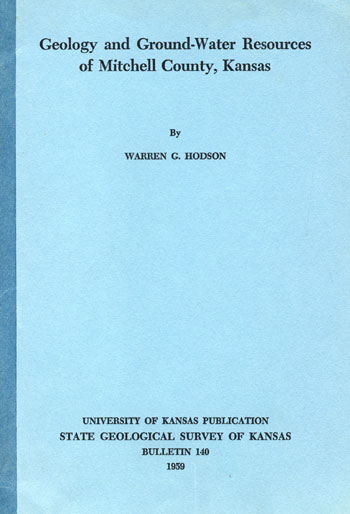Geology and Ground-water Resources of Mitchell County, Kansas
By Warren G. Hodson

Originally published in 1959 as Kansas Geological Survey Bulletin 140. This is, in general, the original text as published. The information has not been updated.
You may also wish to visit our web site on the Mitchell County geologic map.
Abstract
This report describes the geography, geology, and ground-water resources of Mitchell County, north-central Kansas. The county has an area of about 720 square miles and a population of about 10,000. Mitchell County lies within the Smoky Hills physiographic province of Kansas.
The rocks that crop out in Mitchell County are sedimentary and range in age from Cretaceous to Recent. The oldest rocks exposed are sandstone, clay, and shale beds of the Dakota Formation. They are overlain by a conformable sequence of Cretaceous marine rocks classified, in ascending order, as the Graneros Shale, Greenhorn Limestone, Carlile Shale, and Fort Hays Limestone member of the Niobrara Formation. Unconsolidated continental deposits of fluviatile and eolian origin represent three stages of the Pleistocene Epoch. Pleistocene deposits include the Crete Formation and Loveland Formation of Illinoian age, Peoria Formation of Wisconsinan age, and alluvial deposits of Wisconsinan and Recent ages. The surface geology is shown by a map, and cross sections illustrate the stratigraphic relations of the geologic formations.
Ground water in Mitchell County is recharged mainly by local precipitation; ground water is discharged mainly by effluent seepage to streams and by transpiration. Most municipal, industrial, domestic, and stock water supplies are obtained from wells. Moderate supplies of ground water are available from the alluvium and terrace deposits of Solomon Valley, but ground-water supplies in the upland areas are small. A map shows the direction of movement of ground water in Solomon Valley and the location of test holes and wells inventoried in Mitchell County.
In general, ground water in Mitchell County is hard but otherwise suitable for most uses. Waters from some wells, however, contained excessive amounts of certain constituents. The Dakota Formation provides potable ground water only in the eastern part of the county; ground water from the Dakota in the western part is too mineralized for most uses.
The field data upon which this report is based are given in tables. They include records of 310 wells, logs of 60 test holes, and chemical analyses of waters from 53 representative wells.
Kansas Geological Survey, Geology
Placed on web June 16, 2009; originally published April 1959.
Comments to webadmin@kgs.ku.edu
The URL for this page is http://www.kgs.ku.edu/General/Geology/Mitchell/index.html